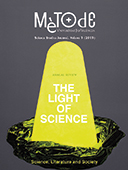El perfil del maltractador masclista. Què ens diu la seua biologia?
DOI:
https://doi.org/10.7203/metode.0.3174Paraules clau:
Hormones, psicobiologia, neurociències, violència masclista Resum
Resum
La consideració dels marcadors psicobiològics de predisposició a la violència dels homes que maltracten les dones obre una porta a la prevenció i la intervenció en el camp de la violència contra les dones. Actualment no disposem de fàrmacs efectius per al tractament de la violència contra les dones, però el desenvolupament de programes d’intervenció psicoterapèutica i de rehabilitació neuropsicològica marca una via d’esperança.
 Descàrregues
Descàrregues
 Referències
Referències
Babcock, J. C.; Green, C. E.; Webb, S. A. and T. P. Yerington, 2005. «Psychophysiological Profiles of Batterers: Autonomic Emotional Reactivity as It Predicts the Antisocial Spectrum of Behavior among Intimate Partner Abusers». Journal of Abnormal Psychology, 114(3): 444-455. DOI: <10.1037/0021-843X.114.3.444>.
Echeburúa-Odriozola, E.; Sarasua-Sanz, B.; Zubizarreta-Anguera, I.; Amor-Andrés, P. J. and P. De Corral-Gargallo, 2010. «Variables predictoras del rechazo, abandono y fracaso terapéutico en hombres violentos contra su pareja tratados psicológicamente en un marco comunitario». International Journal of Clinical and Health Psychology, 10: 403-420.
Farrell, H. M., 2011. «Batterers: a Review of Violence and Risk Assessment Tools». Journal of the American Academy of Psychiatry and the Law, 39: 562-574.
Giancola, P. R.; Duke, A. A. and K. Z. Ritz, 2011. «Alcohol, Violence, and the Alcohol Myopia Model: Preliminary Findings and Implications for Prevention». Addictive Behaviors, 36: 1019-1022. DOI: <10.1016/j.addbeh.2011.05.006>.
Gottman, J. M.; Jacobson, N. S.; Rushe, R. H. and J. W. Shortt, 1995. «The Relationship between Heart Rate Reactivity, Emotionally Aggressive Behavior and General Violence in Batterers». Journal of Family Psychology, 9: 227-248.
Moya-Albiol, L., 2010. Psicobiología de la violencia. Pirámide. Madrid.
Romero-Martínez, A.; González-Bono, E.; Lila, M. and L. Moya-Albiol, 2013a. «Testosterone/Cortisol Ratio in Response to Acute Stress: A Possible Marker of Risk for Marital Violence». Social Neuroscience, 8(3): 240-247. DOI: <10.1080/17470919.2013.772072>.
Romero-Martínez, A.; Lila, M.; Catalá-Miñana, A.; Williams, R. K. and L. Moya-Albiol, 2013b. «The Contribution of Childhood Abuse and Early Androgen Exposure to Impairments in Socio-cognitive Skills in Intimate Partner Violence Perpetrators with High Alcohol Consumption». International Journal of Environmental Research and Public Health, 10(8): 3753-3770. DOI: <10.3390/ijerph10083753>.
Romero-Martínez, A.; Lila, M.; Sariñana-González, P.; González-Bono, E. and L. Moya-Albiol, 2013c. «High Testosterone Levels and Sensitivity to Acute Stress in Perpetrators of Domestic Violence with Low Cognitive Flexibility and Impairments in Their Emotional Decoding Process: A Preliminary Study». Aggressive Behavior, 39(5): 355-369. DOI: <10.1002/ab.21490>.
Romero-Martínez, A.; Lila, M.; Williams, R. K.; González-Bono, E. and L. Moya-Albiol, 2013d. «Skin Conductance Rises in Preparation and Recovery to Psychosocial Stress are Related to Impulsivity and Testosterone in Intimate Partner Violence Perpetrators». International Journal of Psychophysiology, 90(3): 329-333. DOI: <10.1016/j.ijpsycho.2013.10.003>.
Romero-Martínez, A. and L. Moya-Albiol, 2013. «Neuropsychology of Perpetrators of Domestic Violence: The Role of Traumatic Brain Injury and Alcohol Abuse and/or Dependence». Revista de Neurología, 57(11): 515-522.
Romero-Martínez, A.; Lila, M.; Conchell, R.; González-Bono, E. and L. Moya-Albiol, 2014. «Immunoglobulin A Response to Acute Stress in Intimate Partner Violence Perpetrators: The Role of Anger Expression-out and Testosterone». Biological Psychology, 96: 66-71. DOI: <10.1016/j.biopsycho.2013.11.009>.
Terburg, D.; Morgan, B. and J. van Honk, 2009. «The Testosterone–cortisol Ratio: A Hormonal Marker for Proneness to Social Aggression». International Journal of Law and Psychiatry, 32(4), 216-223. DOI: <10.1016/j.ijlp.2009.04.008>.
World Health Organisation, 2011. Multi-country Study on Women’s Health and Domestic Violence Progress Report. OMS. Geneva.
Descàrregues
Publicades
Com citar
-
Resum1122
-
PDF371
-
PDF (Español)816
-
PDF 138
Número
Secció
Llicència
![]()
Tots els documents inclosos en OJS són d'accés lliure i propietat dels seus autors.
Els autors que publiquen en aquesta revista estan d'acord amb els següents termes:
- Els autors conserven els drets d'autor i garanteixen a la revista el dret a la primera publicació del treball, llicenciat baix una llicència de Reconeixement-NoComercial-SenseObraDerivada 4.0 Internacional de Creative Commons, que permet a altres compartir el treball amb un reconeixement de l'autoria del treball i citant la publicació inicial en aquesta revista.
- Es permet i s'anima els autors a difondre la versió definitiva dels seus treballs electrònicament a través de pàgines personals i institucionals (repositoris institucionals, pàgines web personals o perfils a xarxes professionals o acadèmiques) una vegada publicat el treball.





